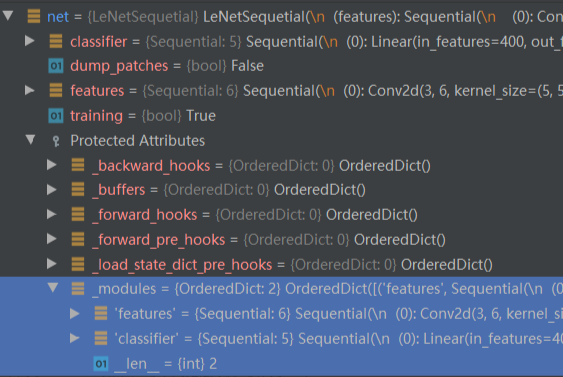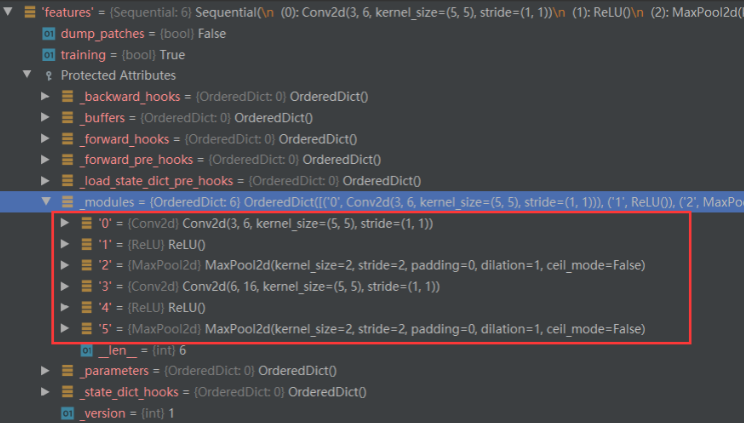PyTorch 模型容器与 AlexNet 构建
文章和代码已经归档至【Github 仓库:https://github.com/timerring/dive-into-AI 】或者公众号【AIShareLab】回复 pytorch 教程 也可获取。
模型容器与 AlexNet 构建
除了上述的模块之外,还有一个重要的概念是模型容器 (Containers),常用的容器有 3 个,这些容器都是继承自nn.Module。
nn.Sequetial:按照顺序包装多个网络层
nn.ModuleList:像 python 的 list 一样包装多个网络层,可以迭代
nn.ModuleDict:像 python 的 dict 一样包装多个网络层,通过 (key, value) 的方式为每个网络层指定名称。
nn.Sequetial
深度学习中,特征提取和分类器这两步被融合到了一个神经网络中。在卷积神经网络中,前面的卷积层以及池化层可以认为是特征提取部分,而后面的全连接层可以认为是分类器部分。比如 LeNet 就可以分为特征提取和分类器两部分,这 2 部分都可以分别使用 nn.Seuqtial 来包装。

代码如下:
在初始化时,nn.Sequetial会调用__init__()方法,将每一个子 module 添加到 自身的_modules属性中。这里可以看到,我们传入的参数可以是一个 list,或者一个 OrderDict。如果是一个 OrderDict,那么则使用 OrderDict 里的 key,否则使用数字作为 key。
网络初始化完成后有两个子 module:features和classifier。

而features中的子 module 如下,每个网络层以序号作为 key:

在进行前向传播时,会进入 LeNet 的forward()函数,首先调用第一个Sequetial容器:self.features,由于self.features也是一个 module,因此会调用__call__()函数,里面调用
result = self.forward(*input, **kwargs),进入nn.Seuqetial的forward()函数,在这里依次调用所有的 module。上一个 module 的输出是下一个 module 的输入。
在上面可以看到在nn.Sequetial中,里面的每个子网络层 module 是使用序号来索引的,即使用数字来作为 key。
一旦网络层增多,难以查找特定的网络层,这种情况可以使用 OrderDict (有序字典)。可以与上面的代码对比一下
总结
nn.Sequetial是nn.Module的容器,用于按顺序包装一组网络层,有以下两个特性。
顺序性:各网络层之间严格按照顺序构建,我们在构建网络时,一定要注意前后网络层之间输入和输出数据之间的形状是否匹配
自带
forward()函数:在nn.Sequetial的forward()函数里通过 for 循环依次读取每个网络层,执行前向传播运算。这使得我们我们构建的模型更加简洁
nn.ModuleList
nn.ModuleList是nn.Module的容器,用于包装一组网络层,以迭代的方式调用网络层,主要有以下 3 个方法:
append():在 ModuleList 后面添加网络层
extend():拼接两个 ModuleList
insert():在 ModuleList 的指定位置中插入网络层
下面的代码通过列表生成式来循环迭代创建 20 个全连接层,非常方便,只是在 forward()函数中需要手动调用每个网络层。
nn.ModuleDict
nn.ModuleDict是nn.Module的容器,用于包装一组网络层,以索引的方式调用网络层,主要有以下 5 个方法:
clear():清空 ModuleDict
items():返回可迭代的键值对 (key, value)
keys():返回字典的所有 key
values():返回字典的所有 value
pop():返回一对键值,并从字典中删除
下面的模型创建了两个ModuleDict:self.choices和self.activations,在前向传播时通过传入对应的 key 来执行对应的网络层。
容器总结
nn.Sequetial:顺序性,各网络层之间严格按照顺序执行,常用于 block 构建,在前向传播时的代码调用变得简洁
nn.ModuleList:迭代行,常用于大量重复网络构建,通过 for 循环实现重复构建
nn.ModuleDict:索引性,常用于可选择的网络层
AlexNet 实现
AlexNet 特点如下:
采用 ReLU 替换饱和激活函数,减轻梯度消失
采用 LRN (Local Response Normalization) 对数据进行局部归一化,减轻梯度消失
采用 Dropout 提高网络的鲁棒性,增加泛化能力
使用 Data Augmentation,包括 TenCrop 和一些色彩修改
AlexNet 的网络结构可以分为两部分:features 和 classifier。

可以在计算机视觉库torchvision.models中找到 AlexNet 的代码,通过看可知使用了nn.Sequential来封装网络层。
版权声明: 本文为 InfoQ 作者【timerring】的原创文章。
原文链接:【http://xie.infoq.cn/article/c1ab51a6da56ab8678f328f48】。未经作者许可,禁止转载。











评论